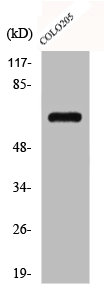![FACS analysis of human peripheral blood using GTX28222 SEMA7A antibody [MEM-150]. FACS analysis of human peripheral blood using GTX28222 SEMA7A antibody [MEM-150].](https://www.genetex.com/upload/website/prouct_img/normal/GTX28222/GTX28222_20191028_WB_1_w_23060722_221.webp)
FACS analysis of human peripheral blood using GTX28222 SEMA7A antibody [MEM-150].
SEMA7A antibody [MEM-150]
GTX28222
ApplicationsFlow Cytometry, ImmunoPrecipitation, Western Blot
Product group Antibodies
TargetSEMA7A
Overview
- SupplierGeneTex
- Product NameSEMA7A antibody [MEM-150]
- Delivery Days Customer9
- ApplicationsFlow Cytometry, ImmunoPrecipitation, Western Blot
- CertificationResearch Use Only
- ClonalityMonoclonal
- Clone IDMEM-150
- Concentration1 mg/ml
- ConjugateUnconjugated
- Gene ID8482
- Target nameSEMA7A
- Target descriptionsemaphorin 7A (John Milton Hagen blood group)
- Target synonymsCD108; CDw108; H-SEMA-K1; H-Sema-L; JMH; JMH blood group antigen; John Milton Hagen blood group H-Sema K1; john-Milton-Hargen human blood group Ag; sema domain, immunoglobulin domain (Ig), and GPI membrane anchor, (semaphorin) 7A (JMH blood group); sema domain, immunoglobulin domain (Ig), and GPI membrane anchor, 7A; sema K1; sema L; SEMAK1; SEMAL; semaphorin 7A, GPI membrane anchor (John Milton Hagen blood group); semaphorin-7A; semaphorin-K1; semaphorin-L
- HostMouse
- IsotypeIgM
- Protein IDO75326
- Protein NameSemaphorin-7A
- Scientific DescriptionThis gene encodes a member of the semaphorin family of proteins. The encoded preproprotein is proteolytically processed to generate the mature glycosylphosphatidylinositol (GPI)-anchored membrane glycoprotein. The encoded protein is found on activated lymphocytes and erythrocytes and may be involved in immunomodulatory and neuronal processes. The encoded protein carries the John Milton Hagen (JMH) blood group antigens. Mutations in this gene may be associated with reduced bone mineral density (BMD). Alternative splicing results in multiple transcript variants, at least one of which encodes an isoform that is proteolytically processed. [provided by RefSeq, Feb 2016]
- Storage Instruction2°C to 8°C
- UNSPSC12352203

![WB analysis of human brain tissue lysate using GTX52991 SEMA7A antibody [99D22].](https://www.genetex.com/upload/website/prouct_img/normal/GTX52991/GTX52991_20191119_WB_w_23060900_591.webp)




